CHEVROLET MONTE CARLO 2007 6.G Owners Manual
Manufacturer: CHEVROLET, Model Year: 2007, Model line: MONTE CARLO, Model: CHEVROLET MONTE CARLO 2007 6.GPages: 456, PDF Size: 2.43 MB
Page 341 of 456
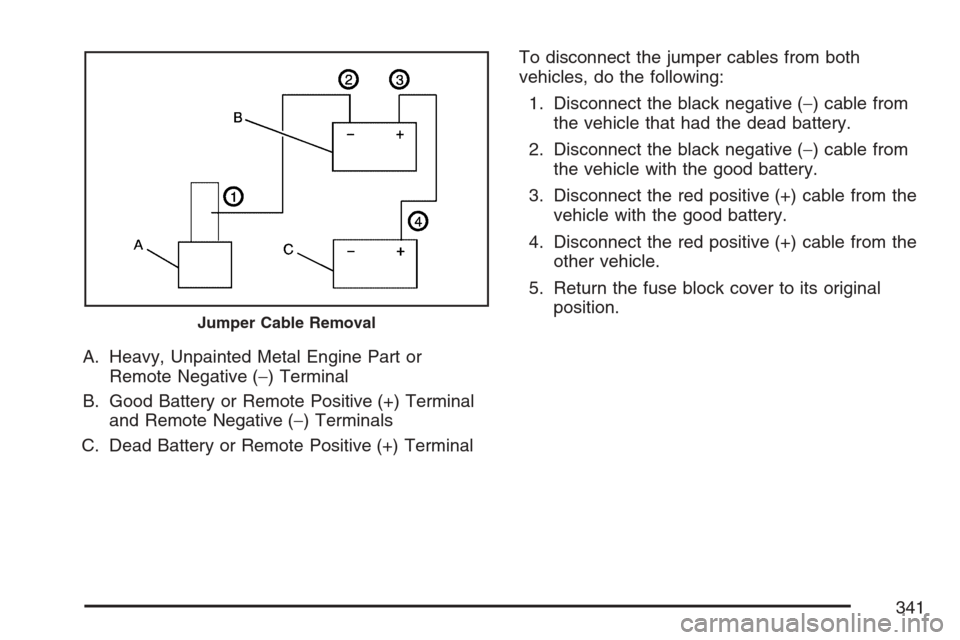
A. Heavy, Unpainted Metal Engine Part or
Remote Negative (−) Terminal
B. Good Battery or Remote Positive (+) Terminal
and Remote Negative (−) Terminals
C. Dead Battery or Remote Positive (+) TerminalTo disconnect the jumper cables from both
vehicles, do the following:
1. Disconnect the black negative (−) cable from
the vehicle that had the dead battery.
2. Disconnect the black negative (−) cable from
the vehicle with the good battery.
3. Disconnect the red positive (+) cable from the
vehicle with the good battery.
4. Disconnect the red positive (+) cable from the
other vehicle.
5. Return the fuse block cover to its original
position.
Jumper Cable Removal
341
Page 342 of 456
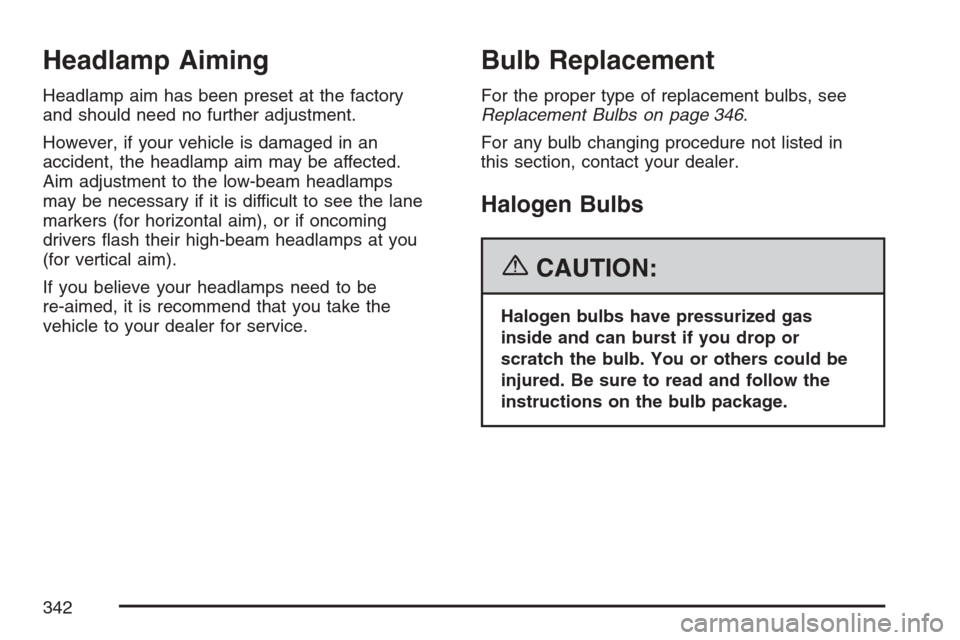
Headlamp Aiming
Headlamp aim has been preset at the factory
and should need no further adjustment.
However, if your vehicle is damaged in an
accident, the headlamp aim may be affected.
Aim adjustment to the low-beam headlamps
may be necessary if it is difficult to see the lane
markers (for horizontal aim), or if oncoming
drivers �ash their high-beam headlamps at you
(for vertical aim).
If you believe your headlamps need to be
re-aimed, it is recommend that you take the
vehicle to your dealer for service.
Bulb Replacement
For the proper type of replacement bulbs, see
Replacement Bulbs on page 346.
For any bulb changing procedure not listed in
this section, contact your dealer.
Halogen Bulbs
{CAUTION:
Halogen bulbs have pressurized gas
inside and can burst if you drop or
scratch the bulb. You or others could be
injured. Be sure to read and follow the
instructions on the bulb package.
342
Page 343 of 456
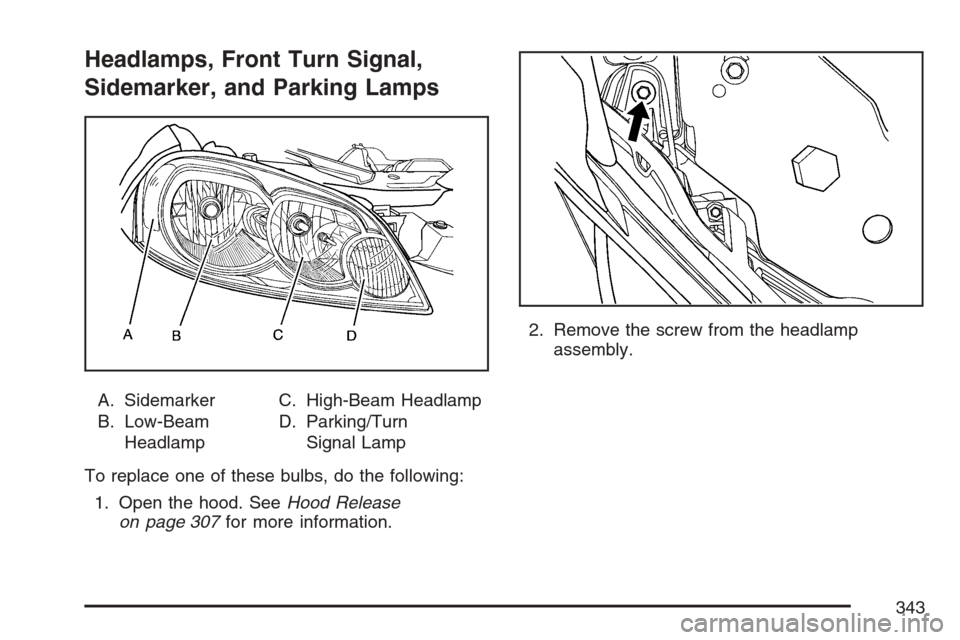
Headlamps, Front Turn Signal,
Sidemarker, and Parking Lamps
A. Sidemarker
B. Low-Beam
HeadlampC. High-Beam Headlamp
D. Parking/Turn
Signal Lamp
To replace one of these bulbs, do the following:
1. Open the hood. SeeHood Release
on page 307for more information.2. Remove the screw from the headlamp
assembly.
343
Page 344 of 456
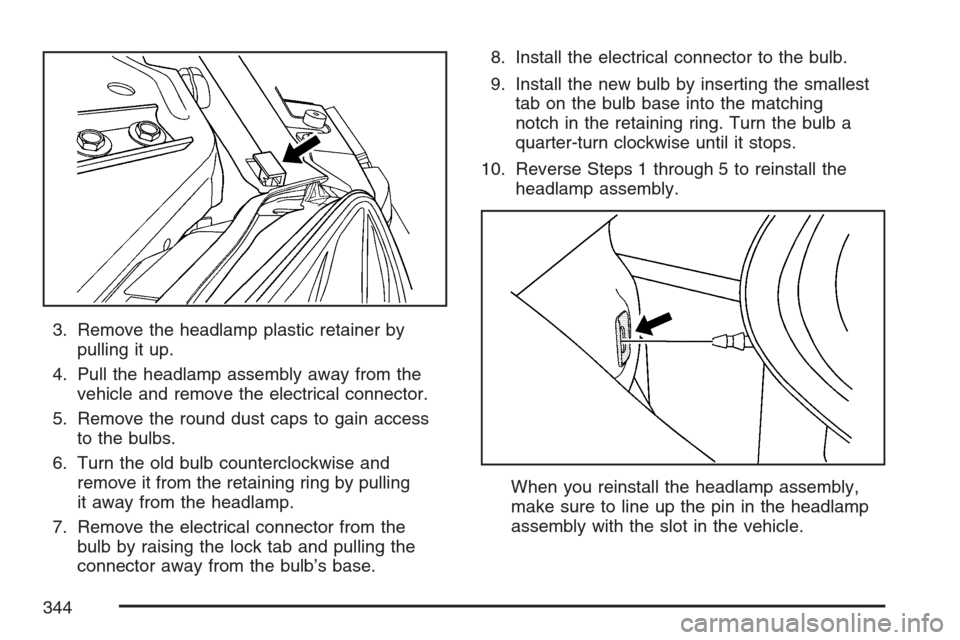
3. Remove the headlamp plastic retainer by
pulling it up.
4. Pull the headlamp assembly away from the
vehicle and remove the electrical connector.
5. Remove the round dust caps to gain access
to the bulbs.
6. Turn the old bulb counterclockwise and
remove it from the retaining ring by pulling
it away from the headlamp.
7. Remove the electrical connector from the
bulb by raising the lock tab and pulling the
connector away from the bulb’s base.8. Install the electrical connector to the bulb.
9. Install the new bulb by inserting the smallest
tab on the bulb base into the matching
notch in the retaining ring. Turn the bulb a
quarter-turn clockwise until it stops.
10. Reverse Steps 1 through 5 to reinstall the
headlamp assembly.
When you reinstall the headlamp assembly,
make sure to line up the pin in the headlamp
assembly with the slot in the vehicle.
344
Page 345 of 456
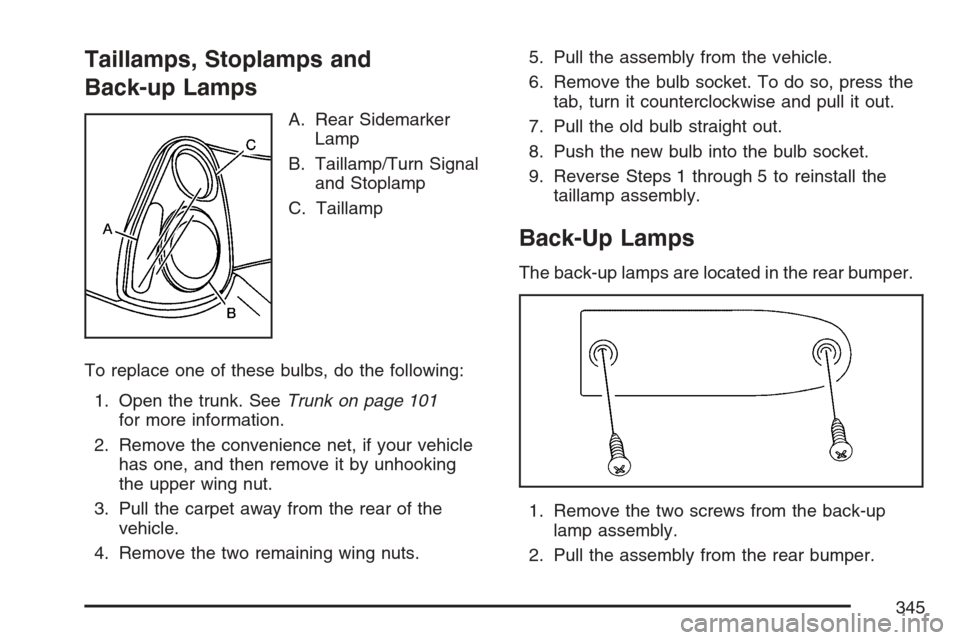
Taillamps, Stoplamps and
Back-up Lamps
A. Rear Sidemarker
Lamp
B. Taillamp/Turn Signal
and Stoplamp
C. Taillamp
To replace one of these bulbs, do the following:
1. Open the trunk. SeeTrunk on page 101
for more information.
2. Remove the convenience net, if your vehicle
has one, and then remove it by unhooking
the upper wing nut.
3. Pull the carpet away from the rear of the
vehicle.
4. Remove the two remaining wing nuts.5. Pull the assembly from the vehicle.
6. Remove the bulb socket. To do so, press the
tab, turn it counterclockwise and pull it out.
7. Pull the old bulb straight out.
8. Push the new bulb into the bulb socket.
9. Reverse Steps 1 through 5 to reinstall the
taillamp assembly.
Back-Up Lamps
The back-up lamps are located in the rear bumper.
1. Remove the two screws from the back-up
lamp assembly.
2. Pull the assembly from the rear bumper.
345
Page 346 of 456
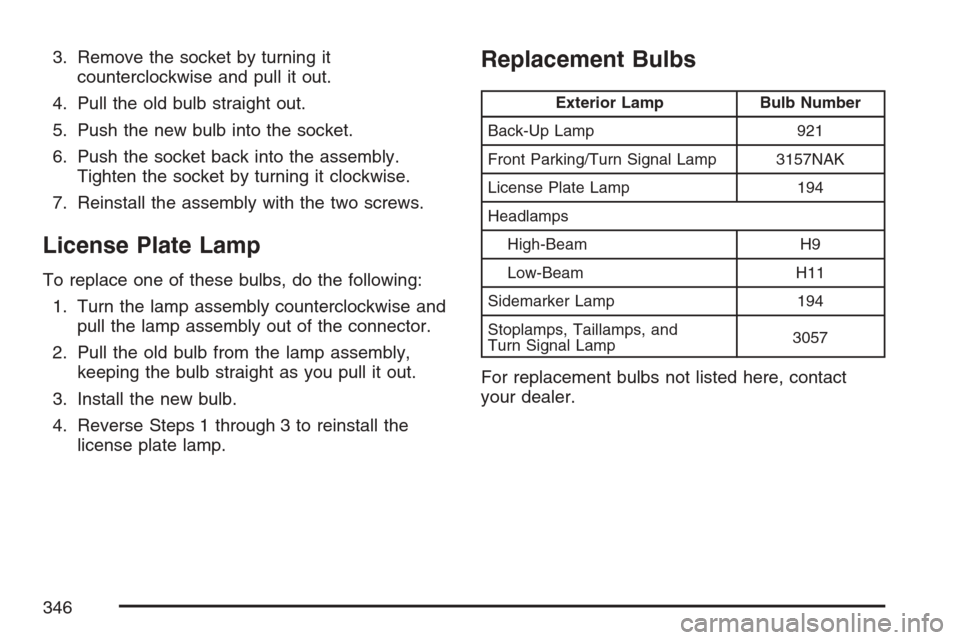
3. Remove the socket by turning it
counterclockwise and pull it out.
4. Pull the old bulb straight out.
5. Push the new bulb into the socket.
6. Push the socket back into the assembly.
Tighten the socket by turning it clockwise.
7. Reinstall the assembly with the two screws.
License Plate Lamp
To replace one of these bulbs, do the following:
1. Turn the lamp assembly counterclockwise and
pull the lamp assembly out of the connector.
2. Pull the old bulb from the lamp assembly,
keeping the bulb straight as you pull it out.
3. Install the new bulb.
4. Reverse Steps 1 through 3 to reinstall the
license plate lamp.
Replacement Bulbs
Exterior Lamp Bulb Number
Back-Up Lamp 921
Front Parking/Turn Signal Lamp 3157NAK
License Plate Lamp 194
Headlamps
High-Beam H9
Low-Beam H11
Sidemarker Lamp 194
Stoplamps, Taillamps, and
Turn Signal Lamp3057
For replacement bulbs not listed here, contact
your dealer.
346
Page 347 of 456
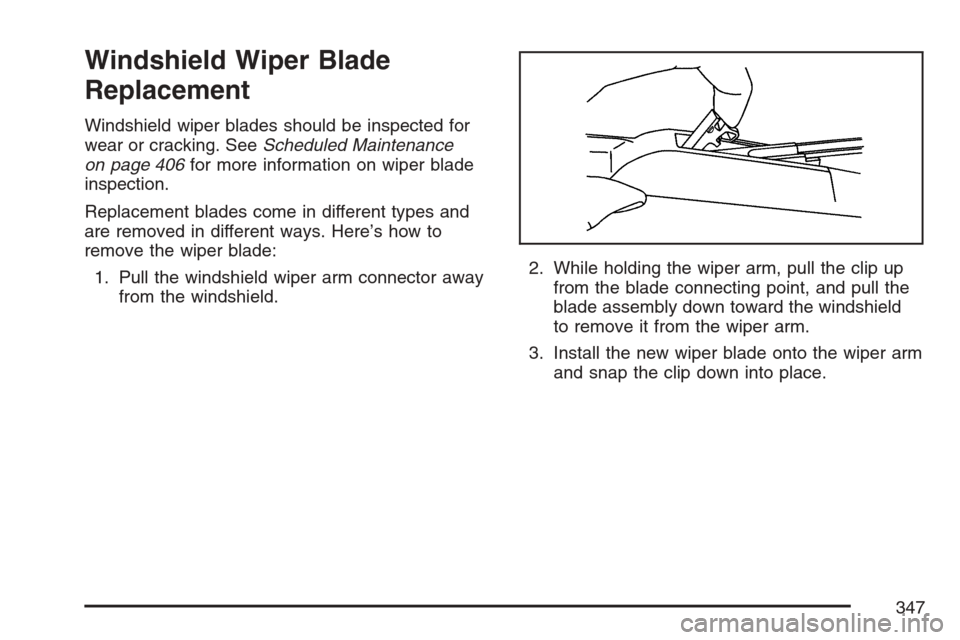
Windshield Wiper Blade
Replacement
Windshield wiper blades should be inspected for
wear or cracking. SeeScheduled Maintenance
on page 406for more information on wiper blade
inspection.
Replacement blades come in different types and
are removed in different ways. Here’s how to
remove the wiper blade:
1. Pull the windshield wiper arm connector away
from the windshield.2. While holding the wiper arm, pull the clip up
from the blade connecting point, and pull the
blade assembly down toward the windshield
to remove it from the wiper arm.
3. Install the new wiper blade onto the wiper arm
and snap the clip down into place.
347
Page 348 of 456
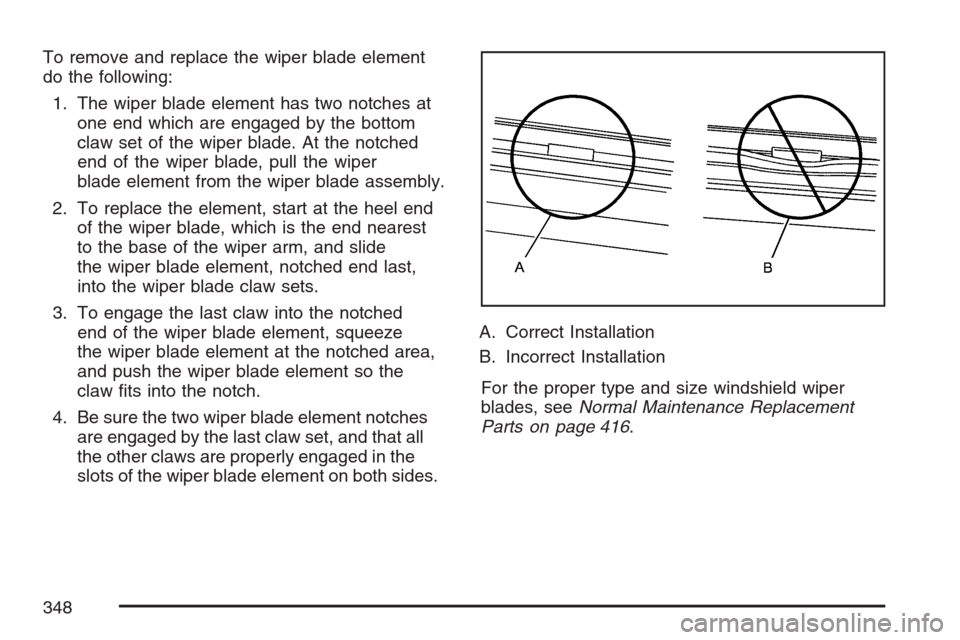
To remove and replace the wiper blade element
do the following:
1. The wiper blade element has two notches at
one end which are engaged by the bottom
claw set of the wiper blade. At the notched
end of the wiper blade, pull the wiper
blade element from the wiper blade assembly.
2. To replace the element, start at the heel end
of the wiper blade, which is the end nearest
to the base of the wiper arm, and slide
the wiper blade element, notched end last,
into the wiper blade claw sets.
3. To engage the last claw into the notched
end of the wiper blade element, squeeze
the wiper blade element at the notched area,
and push the wiper blade element so the
claw �ts into the notch.
4. Be sure the two wiper blade element notches
are engaged by the last claw set, and that all
the other claws are properly engaged in the
slots of the wiper blade element on both sides.A. Correct Installation
B. Incorrect Installation
For the proper type and size windshield wiper
blades, seeNormal Maintenance Replacement
Parts on page 416.
348
Page 349 of 456
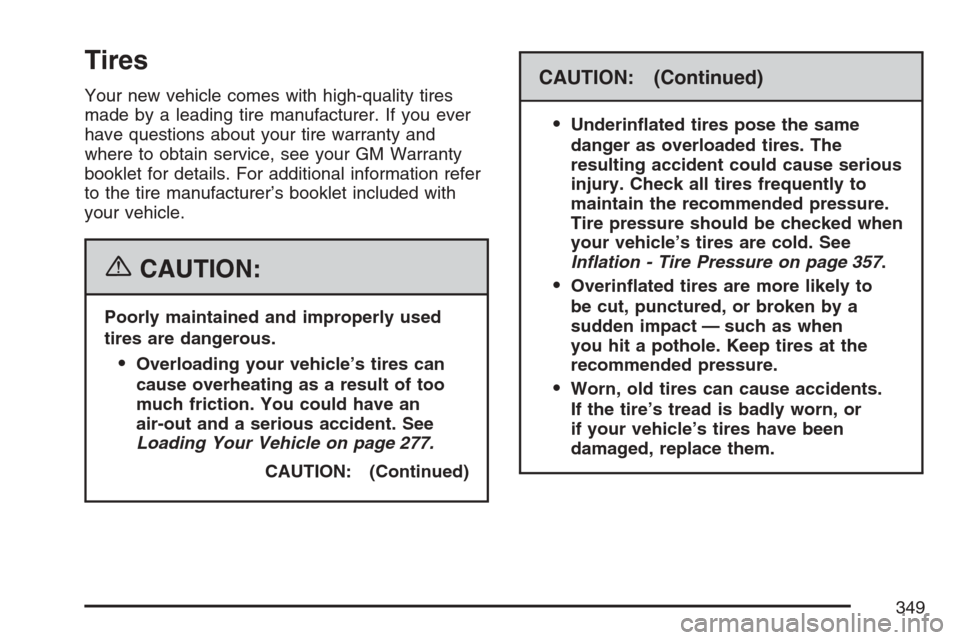
Tires
Your new vehicle comes with high-quality tires
made by a leading tire manufacturer. If you ever
have questions about your tire warranty and
where to obtain service, see your GM Warranty
booklet for details. For additional information refer
to the tire manufacturer’s booklet included with
your vehicle.
{CAUTION:
Poorly maintained and improperly used
tires are dangerous.
Overloading your vehicle’s tires can
cause overheating as a result of too
much friction. You could have an
air-out and a serious accident. See
Loading Your Vehicle on page 277.
CAUTION: (Continued)
CAUTION: (Continued)
Underin�ated tires pose the same
danger as overloaded tires. The
resulting accident could cause serious
injury. Check all tires frequently to
maintain the recommended pressure.
Tire pressure should be checked when
your vehicle’s tires are cold. See
Inflation - Tire Pressure on page 357.
Overin�ated tires are more likely to
be cut, punctured, or broken by a
sudden impact — such as when
you hit a pothole. Keep tires at the
recommended pressure.
Worn, old tires can cause accidents.
If the tire’s tread is badly worn, or
if your vehicle’s tires have been
damaged, replace them.
349
Page 350 of 456
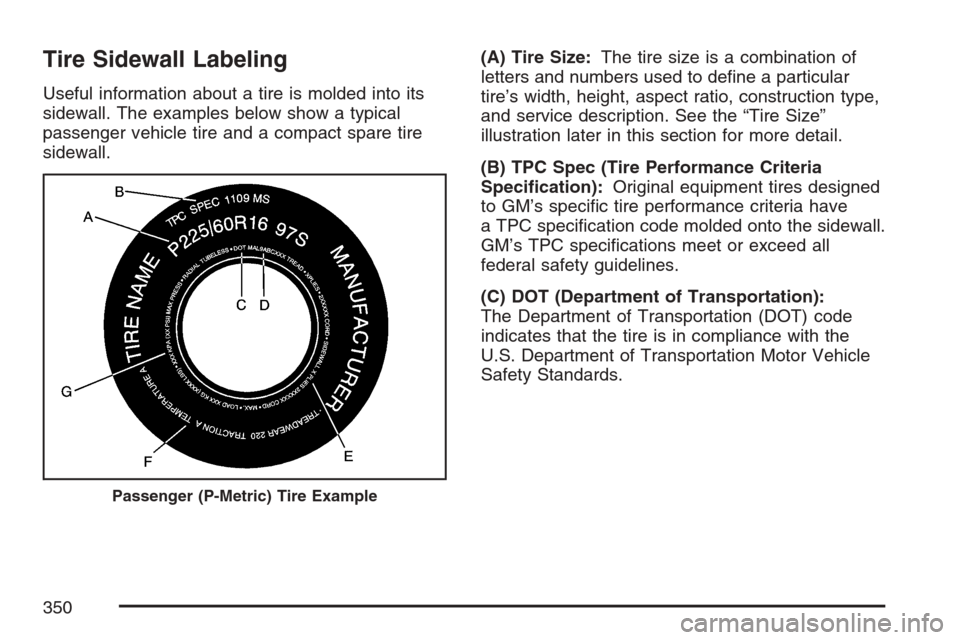
Tire Sidewall Labeling
Useful information about a tire is molded into its
sidewall. The examples below show a typical
passenger vehicle tire and a compact spare tire
sidewall.(A) Tire Size:The tire size is a combination of
letters and numbers used to de�ne a particular
tire’s width, height, aspect ratio, construction type,
and service description. See the “Tire Size”
illustration later in this section for more detail.
(B) TPC Spec (Tire Performance Criteria
Speci�cation):Original equipment tires designed
to GM’s speci�c tire performance criteria have
a TPC speci�cation code molded onto the sidewall.
GM’s TPC speci�cations meet or exceed all
federal safety guidelines.
(C) DOT (Department of Transportation):
The Department of Transportation (DOT) code
indicates that the tire is in compliance with the
U.S. Department of Transportation Motor Vehicle
Safety Standards.
Passenger (P-Metric) Tire Example
350